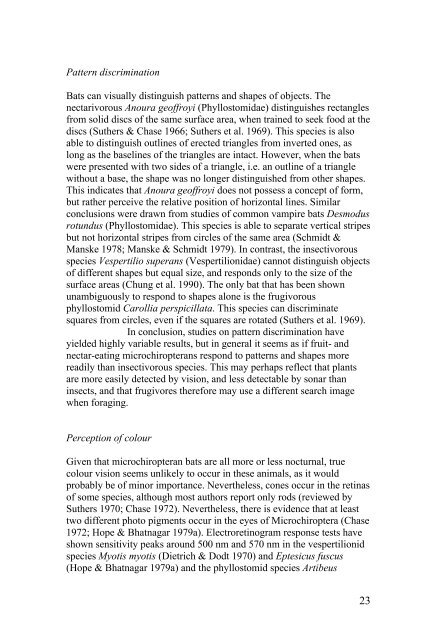Vision in echolocating bats - Fladdermus.net
Vision in echolocating bats - Fladdermus.net
Vision in echolocating bats - Fladdermus.net
Create successful ePaper yourself
Turn your PDF publications into a flip-book with our unique Google optimized e-Paper software.
Pattern discrim<strong>in</strong>ation<br />
Bats can visually dist<strong>in</strong>guish patterns and shapes of objects. The<br />
nectarivorous Anoura geoffroyi (Phyllostomidae) dist<strong>in</strong>guishes rectangles<br />
from solid discs of the same surface area, when tra<strong>in</strong>ed to seek food at the<br />
discs (Suthers & Chase 1966; Suthers et al. 1969). This species is also<br />
able to dist<strong>in</strong>guish outl<strong>in</strong>es of erected triangles from <strong>in</strong>verted ones, as<br />
long as the basel<strong>in</strong>es of the triangles are <strong>in</strong>tact. However, when the <strong>bats</strong><br />
were presented with two sides of a triangle, i.e. an outl<strong>in</strong>e of a triangle<br />
without a base, the shape was no longer dist<strong>in</strong>guished from other shapes.<br />
This <strong>in</strong>dicates that Anoura geoffroyi does not possess a concept of form,<br />
but rather perceive the relative position of horizontal l<strong>in</strong>es. Similar<br />
conclusions were drawn from studies of common vampire <strong>bats</strong> Desmodus<br />
rotundus (Phyllostomidae). This species is able to separate vertical stripes<br />
but not horizontal stripes from circles of the same area (Schmidt &<br />
Manske 1978; Manske & Schmidt 1979). In contrast, the <strong>in</strong>sectivorous<br />
species Vespertilio superans (Vespertilionidae) cannot dist<strong>in</strong>guish objects<br />
of different shapes but equal size, and responds only to the size of the<br />
surface areas (Chung et al. 1990). The only bat that has been shown<br />
unambiguously to respond to shapes alone is the frugivorous<br />
phyllostomid Carollia perspicillata. This species can discrim<strong>in</strong>ate<br />
squares from circles, even if the squares are rotated (Suthers et al. 1969).<br />
In conclusion, studies on pattern discrim<strong>in</strong>ation have<br />
yielded highly variable results, but <strong>in</strong> general it seems as if fruit- and<br />
nectar-eat<strong>in</strong>g microchiropterans respond to patterns and shapes more<br />
readily than <strong>in</strong>sectivorous species. This may perhaps reflect that plants<br />
are more easily detected by vision, and less detectable by sonar than<br />
<strong>in</strong>sects, and that frugivores therefore may use a different search image<br />
when forag<strong>in</strong>g.<br />
Perception of colour<br />
Given that microchiropteran <strong>bats</strong> are all more or less nocturnal, true<br />
colour vision seems unlikely to occur <strong>in</strong> these animals, as it would<br />
probably be of m<strong>in</strong>or importance. Nevertheless, cones occur <strong>in</strong> the ret<strong>in</strong>as<br />
of some species, although most authors report only rods (reviewed by<br />
Suthers 1970; Chase 1972). Nevertheless, there is evidence that at least<br />
two different photo pigments occur <strong>in</strong> the eyes of Microchiroptera (Chase<br />
1972; Hope & Bhatnagar 1979a). Electroret<strong>in</strong>ogram response tests have<br />
shown sensitivity peaks around 500 nm and 570 nm <strong>in</strong> the vespertilionid<br />
species Myotis myotis (Dietrich & Dodt 1970) and Eptesicus fuscus<br />
(Hope & Bhatnagar 1979a) and the phyllostomid species Artibeus<br />
23


